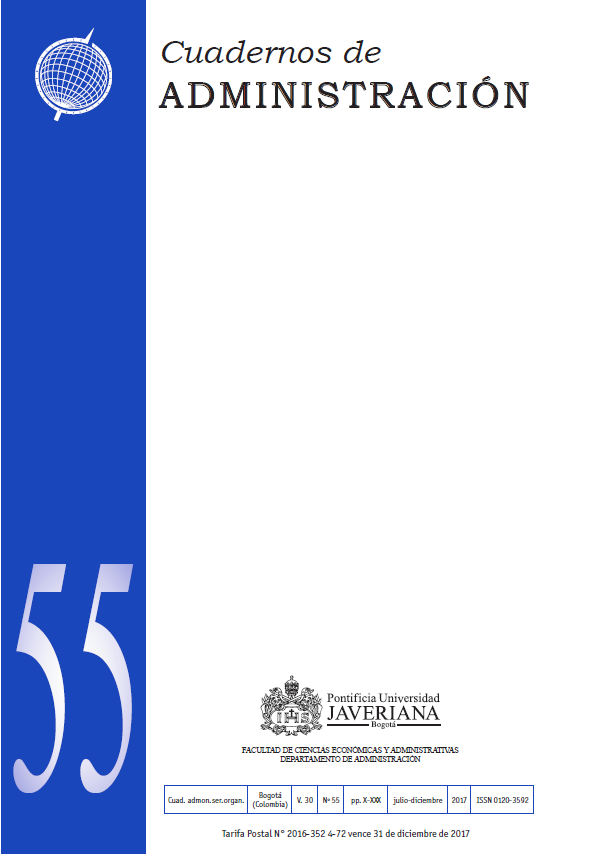Firm’s Knowledge Base and its impact on absorptive capacity in Low-tech SMEs
##plugins.themes.bootstrap3.article.details##
This paper examines the effects of the firm’s knowledge base on the absorptive capacity (ACAP) in low-tech SMEs, emphasizing on the mediating role of organizational antecedents. For this purpose, an econometrical
approach known as structural equation modeling was undertaken based on data collected from a survey applied to 96 firms belonging to agro-industrial and logistics service sectors from the department of Atlántico, Colombia. Results suggest that knowledge base is not sufficient to generate significant impacts on the firm’s ACAP, in fact, it requires the mediation of organizational antecedents. In particular, the deployment
of internal communication networks (socialization skills) to capitalize employee’s capabilities in benefit of the firm’s absorptive capacity.
Absorptive capacity, knowledge base, socialization capabilities, formalization, innovation, R&DCapacidad de Absorción, Base de conocimiento, Capacidades de Socialización, Formalización, Innovación, I Dcapacidade de absorção, base de conhecimento, capacidades de socialização, formalização, inovação, P D
Becker, W., Dietz, J. (2004). R&D cooperation and innovation activities of firms-evidence for the German industry. Research Policy, 33, 209–223.
Caloghirou,Y., Kastelli, I., Tsakanikas, A. (2004). Internal capabilities and external knowledge sources: complements or substitutes for innovative performance?. Technovation, 24 (1), 29-39.
Cassiman, B., Veugelers, R. (2006). In search of complementarity in innovation strategy: internal R&D and external knowledge acquisition. Management Science 52, 68-82.
Christensen, C., Overdorf, M. 2000. Meeting the challenge of disruptive change. Harvard Business Review, 78(2): 66 –76.
Cohen,W.M., Levinthal,D.A. 1989. Innovation and Learning: The two faces of R&D. The Economic Journal, 99, 569-596.
Cohen, W. M., Levinthal, D. A. (1990). Absorptive capacity: A new perspective on learning and innovation. Administrative science quarterly, 128-152.
Coombs, J.E., Bierly, P.E. (2006). Measuring technological capability and performance. R&D Maanagment, 36 (4), 421-438.
Freel, M. S. (2005). Patterns of innovation and skills in small firms. Technovation, 25(2), 123-134.
Garcia-Granero, A; Vega-Jurado, J., Alegre-Vidal, J. (2014). Is R&D enough to take advantage fron external knowledge? Focusing on coordination Mechanisms. Journal of Technology management and Innovation, 9 (2), 118-130.
Gray, C. (2006). Absorptive capacity, knowledge management and innovation in entrepreneurial small firms. International Journal of Entrepreneurial Behavior & Research, 12(6), 345-360.
Hair, J. F., Black, W. C., Babin, B. J., Anderson, R. E. (2010). Multivariate data analysis (7 ed.). Upper Saddle River, NJ, USA: Prentice-Hall, Inc.
Kim, L. (1998). Crisis construction and organizational learning: Capability building in catching-up at Hyundai Motor. Organization science, 9(4), 506-521.
Lane, P.J., Lubatkin, M. 1998. Relative absorptive capacity and inter-organizational learning. Strategic Management Journal, 19, 461-477.
Leiponen, A. (2005). Skills and innovation. International Journal of Industrial Organization, 23(5), 303-323.
Lenox, M. and King, A. (2004) Prospects for developing absorptive capacity through internal information provision. Strategic Management Journal, 25, 331-345.
Lowe, J., Taylor, P. (1998). R&D and technology purchase through licence agreements: complementary strategies and complementary assets. R&D Management, 28 (4), 263–278.
Mowery, D.C., Oxley, J.E. (1995). Inward technology transfer and competitiveness: The role of national innovation systems. Cambridge Journal of Economics, 19, 67-93.
Nelson, R. R. y S.G. Winter, 1982. An Evolutionary Theory of Economic Change. Harvard University Press, Cambridge, Mass.
Østergaard, C. R., Timmermans, B., Kristinsson, K. (2011). Does a different view create something new? The effect of employee diversity on innovation. Research Policy, 40(3), 500-509.
Parrotta, P., Pozzoli, D., Pytlikova, M. (2014). The nexus between labor diversity and firm’s innovation. Journal of Population Economics, 27(2), 303-364.
Romijn, H., Albaladejo, M. (2002). Determinants of innovation capability in small electronics and software firms in southeast England. Research policy, 31(7), 1053-1067.
Souitaris, V. (2002). Firm–specific competencies determining technological innovation: A survey in Greece. R&D Management, 32(1), 61-77.
Subramaniam, M., Youndt, M. A. (2005). The influence of intellectual capital on the types of innovative capabilities. Academy of Management journal, 48(3), 450-463.
Teece, D. (1996). Firm organization, industrial structure and technological innovation. Journal of Economic Behaviour and Organisation, 31, 193-224.
Tripsas, M., Gavetti, G. (2000). Capabilities, cognition and inertia: Evidence from digital imaging. Strategic Management journal, 21, 1147-1162.
Van Den Bosch, F. A., Volberda, H. W., De Boer, M. (1999). Coevolution of firm absorptive capacity and knowledge environment: Organizational forms and combinative capabilities. Organization science, 10(5), 551-568.
Veugelers, R. (1997). Internal R&D expenditures and external technology sourcing. Research Policy, 26(3), 303-315.
Vega‐Jurado, J., Gutiérrez‐Gracia, A., Fernández‐de‐Lucio, I. (2008). Analyzing the determinants of firm's absorptive capacity: beyond R&D. R&D Management, 38(4), 392-405.
Vinding, A.L. (2000) Absorptive capacity and innovative performance: a human capital approach. Department of Business Studies, DRUID/IKE Group. Aalborg University. Denmark.
Vinding, A.L. (2006). Absorptive capacity and innovative performance: A human capital approach. Economics of Innovation and New Technology, 15(4-5), 507-517.
Walls, J.P., Ungson, G.R. (1991). Organizational memory. Academy of Management Review, 16, 57-91.
Zahra, S. A., George, G. (2002). Absorptive capacity: A review, reconceptualization, and extension. Academy of management review, 27(2), 185-203.
Zander, U., Kogut, B. (1995). Knowledge and the speed of the transfer and imitation of organizational capabilities: An empirical test. Organization Science, 6, 76–92.


